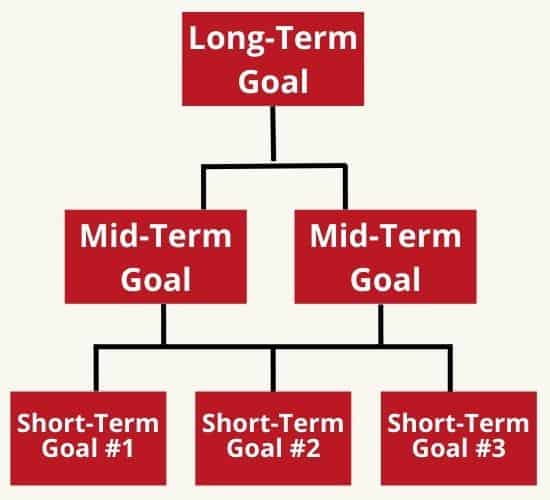10 Steps For Reaching Your Goals
No matter what you want out of life, setting and achieving goals is the foundation for success. To help you on your personal growth journey, I will share how to achieve your goals in 10 easy steps. Let’s get moving so you can start improving!
How To Achieve Your Goals In Life
- Create a vision of your future self.
- Assess your current.
- Select from the different types of goals.
- Prioritize your goals to align with your vision.
- Use a proven goal-setting system.
- Write your goals down and make a plan.
- Use a goal tree.
- Create a vision board.
- Take action and work on your plan.
- Monitor your progress and assess your results.
Next, let’s review each of these ten steps in detail.

Disclosure: At no cost to you, I may get commissions for purchases made through links in this post.
1. Create A Vision Of Your Future Self
A destination is essential when you take a trip or start a journey. For example, you wouldn’t just jump in your car and start driving without a clear idea of where you are going.
The same point is valid for your goals. Do not waste time setting goals without a good idea of your destination. Your vision of your future self is your destination.
Develop your vision by asking yourself questions like…
- What is important to me?
- What is my highest level of education?
- What kind of job will I have?
- Where will I live?
- With whom will I spend my time?
- Will I have a family?
- How much money do I need and want?
- What kind of house will I live in?
- What is my physical fitness level?
- How long do I want to work?
- What relationships are meaningful to me?
When creating your vision, think and dream big. Do not have limiting thoughts that restrict your vision of your best self.
Finally, make sure your vision is yours and no one else’s. It is okay to listen and learn from others. However, determine and cut your unique path to success.
2. Assess Your Current State
Every journey has a destination AND a starting point. So, I suggest you take stock of your current situation.
First, go back to the questions in step 1 and honestly assess where you are at today.
Second, perform a SWOT analysis to identify your:
- Strengths
- Weaknesses
- Opportunities
- Threats
Using what you have learned, determine where you stand today compared to your vision.
Are you starting to see what I’m getting at? Creating goals and achieving those goals begins with two things.
First, where am I at? And second, where am I going?
Then, with that knowledge of your current and future states in place, you are ready for step 3.
3. Select From The Different Types Of Goals That Fit With Your Vision
Your possible goals can be grouped into major categories as follows:
- Educational goals
- Personal goals
- Career goals
- Business goals
- Financial goals
- Relationship goals
- Spiritual goals
Within these goal categories are dozens of potential short and long-term goal opportunities.
I won’t go into all of the possibilities here. However, if you need goal ideas, check out this article: 7 Types Of Goals to Set Now (With 100+ Examples).
So, the question is, how do you decide which goals to select for yourself? Let’s discuss this topic next.
But before we do so, please:
Click and save this image for later on Pinterest!

4. Prioritize Your Goals To Align With Your Vision
To choose your goals, look at your assessment of your current state. Consider your current state point A.
Next, think about the vision for your future self, also known as point B.
Now, determine what goals will help you move from point A to point B.
Selecting goals is easy after determining where you are (current state) and where you want to go (future vision).
Okay. You have selected your goals. Next, it’s time for you to dive into goal setting.
5. Use A Proven Goal-Setting System
I recommend using one of two goal-setting systems to set your goals.
Setting SMART Goals
SMART goal-setting is a popular choice. It says each of your goals should have the following five attributes:
- Specific
- Measurable
- Achievable
- Realistic
- Time-bound
Specific
The first step in making a SMART goal is to make it specific.
To do so, address these questions:
- What is to be accomplished?
- Who needs to be involved?
- Why is it essential to achieve the goal?
The more details about the goal that you can document, the better. Be clear on what you want to accomplish and what is required for success.
Measurable
Make your goals in life measurable. Decide what information will you use to measure your progress.
Measuring some goals is simple. For example, financial goals tend to be easily measured. Measurement of other types of goals is more complicated.
Achievable
Stretch yourself and make your goals challenging. Choose goals that will make a big difference when you achieve them.
Conversely, there is no need to set a goal if it can’t be achieved. By being specific, you should now understand whether a goal is achievable.
For example, don’t set a goal to become a doctor if you don’t have the academic credentials to get into medical school. Thus, becoming a doctor is not achievable.
Relevant
Make your goals relevant. A relevant goal makes sense for you and your situation.
Here’s an extreme example. If you want to become a priest, don’t set a goal to get married. Priests aren’t allowed to get married, so the goal is not relevant.
Time-Bound
SMART goals are time-bound. Thus, you must set a date to achieve your goal.
First, having a deadline will increase your sense of urgency. Second, a time constraint will increase your odds of success. Finally, when multiple steps are involved to achieve a goal, an end date allows you to work backward and create milestones.
Okay. That wraps up a brief review of setting SMART goals. Next, I have another goal-setting system for your consideration.
Setting HARD Goals
The HARD goal-setting system is not as well known. It says each of your goals should have these four attributes:
- Heartfelt
- Animated
- Required
- Difficult
Let’s discuss each one.
Heartfelt
A heartfelt goal is something you care about deeply. When you care, your chances of success increase significantly.
When you do not sincerely care about a goal, why set it in the first place?
However, don’t be careless. For example, just because you don’t care about having a financial emergency fund doesn’t mean you shouldn’t set a goal to have one.
Animated
Making a goal animated means creating a vision of what achieving the goal looks and feels like.
Just like you created a long-term vision of your future self, create a vision for each one of the goals that you have now selected.
Daydream about your goals. Think about them often. Doing so makes your goals come alive in your mind.
Required
Make your goals required.
When you feel like a goal is needed for your success and happiness, you are more likely to accomplish that goal.
Difficult
Finally, your goals should be challenging.
Achieving challenging but achievable goals is where true life transformation takes place.
Next, I have a significant point on your way to setting and achieving your life objectives. Let’s continue with step 6.
6. Write Your Goals Down And Make A Plan
Take what you have from using the SMART or HARD goal-setting system and write your goals.
Documenting your goals is critical. Doing so builds your commitment. Writing things down also helps you clarify your thoughts.
For goals that will take many months to achieve, make a plan. Fill the plan with shorter-term milestones that support ultimate goal achievement.
A goal tree will help with the goal-planning process. Let’s discuss goal trees next.
7. Use A Goal Tree

A goal tree is a great tool. This goal-setting method is used to outline and visualize milestones along your journey.
In other words, the tree outlines the stepping stones required to achieve challenging long-term goals.
Your short-term goals are the roots in the ground. Medium-term goals are the trunk and main branches. At the same time, long-term goals are the canopy of leaves.
Thus, the roots, trunk, and branches connect and support the leaves just like your short and medium-term goals relate to your long-term goals.
Here’s another tip to help you achieve your goals after setting them.
8. Create A Vision Board For Your Goals

A goals vision board is a collection of images, phrases, and inspirational quotes. The board represents your objectives and dreams.
A vision board is a way to bring your vision to life in a tangible form.
Its purpose is to help you see what success looks like. Also, it will motivate and inspire you to reach your goals.
To create your board…
First, find images that display your vision.
For example, a picture of your dream home, the furnishings that will go in it, and the patio for enjoying your outdoor space.
Second, gather supplies for your vision board.
It would be best to have an open wall, corkboard, or poster board. Please put it in a visible place so you will see it daily.
Finally, use the images you have collected and mount them on your vision board. Use spatial and time elements to create your board to depict your future vision.

Next up is step number 9 for setting and achieving your goals.
9. Take Action And Work On Your Plan
Now that your journey is mapped out from short-term steps to long-term vision, it’s time to get busy and work on your plan.
Establish a to-do list for every day and every week. Include tasks for accomplishing your most important goals.
10. Monitor Your Progress To Assess Your Results
From time to time, step back and look at your progress. Are you on the schedule you set as part of making time-bound goals?
What setbacks have you encountered? And how can you learn from them?
Finally, identify your successes. Be sure to celebrate and reward yourself along the way.
Then, replace completed goals with new ones to continue your personal development journey.
Okay. That completes my review of 10 steps for achieving your goals. Good luck no matter what you choose to do.
Author Bio: Tom Scott founded the consulting and coaching firm Dividends Diversify, LLC. He leverages his expertise and decades of experience in goal setting, relocation assistance, and investing for long-term wealth to help clients reach their full potential.